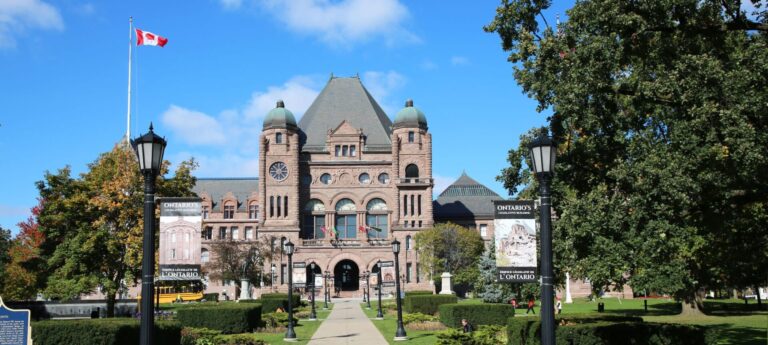Tuesday, August 19, 2025
The United States Administration has unceremoniously announced it plans to impose tariffs of 25 per cent on Canadian goods, and a tariff of 10 per cent on energy exports from Canada. Initially, these tariffs were supposed to take effect on February 4, but following a meeting today with Prime Minister Justin Trudeau, U.S. President Donald Trump decided to drop his plan for at least 30 days.
“Proposed tariffs will be paused for at least 30 days while we work together,” stated Trudeau on social media.
The U.S. claims the tariffs are aimed at compelling Canada to take stronger measures against illegal immigration and the trafficking of fentanyl into the U.S. — even though data indicate less than one per cent of the fentanyl and illegal crossings into the U.S. come from Canada. In response to this U.S. concern, the Government of Canada announced additional investments of $1.3 billion as part of Canada’s Border Plan that bolster border security, strengthen the immigration system, and further reduce the trafficking of drugs and other harmful substances. In today’s meeting Trudeau made a series of further commitments to improve border security.
However, critical thinkers are alluding to ulterior motives for the looming trade war, pointing to a geopolitical storm accelerated by climate change and a play for global domination of Arctic land, coastline and trade routes that provide access to massive reserves of critical minerals, oil, gas and water.
What will be the impacts of the potential tariffs to the environment and energy sectors?
Industry impacts on both sides of the border
Approximately US$2.5 billion in goods and services has been crossing the Canada-U.S. border on a daily basis. This amounts to nearly US$1 trillion per year. Canada and the U.S. also have a significant investment relationship. The U.S. is the single greatest investor in Canada and at the end of 2023, Canada was the largest source of foreign direct investment in the U.S. And Canada is the single largest foreign supplier of energy to the U.S.
During the past few decades, trade between Canada and the U.S. has been governed by a variety of free trade agreements. The Canada-U.S. Free Trade Agreement (CUSFTA), implemented in 1989, was the first of its kind, followed by the North American Free Trade Agreement (NAFTA) in 1994, which added Mexico. The most recent evolution of this agreement is the Canada-U.S.-Mexico Agreement (CUSMA), which entered into force in July 2020 which balances trade relationships across the North American continent and facilitates trade across all sections of the economies.
Furthermore, the Commission for Environmental Cooperation (CEC) is an intergovernmental organization established by Canada, Mexico and the U.S. to implement the North American Agreement on Environmental Cooperation (NAAEC), the environmental side accord to NAFTA. In fact, the CEC recently appointed a Canadian as the chair person.
According to Statistics Canada, the value of Canadian exports to the United States in 2023 exceeded $594 billion. More than 43 per cent of that came from just six industries:
- oil and gas extraction;
- oil and gas refining;
- auto manufacturing;
- aluminum production and processing;
- aerospace and; and,
- crop and animal production.
The U.S. is currently Canada’s largest trading partner. While Canada’s total exports to the U.S. from all industries came to $594 billion in 2023, its total exports to all other countries combined reached only $174 billion — meaning more than 77 per cent of all Canadian exports went to the U.S.
On February 3, in response to impending tariffs for Canada, Mexico and China, the stock markets took a tumble, with more than 90 per cent of the S&P’s 500 constituents negative early Monday. (The S&P 500 measures the total current market value of the stocks of the 500 largest corporations listed on U.S. stock exchanges. Formally known as the Standard & Poor’s 500 Index, the S&P 500 serves as a quick snapshot of the state of the stock markets.) Business and manufacturing groups around the world and in the U.S. criticized Trump’s tariffs, with U.S. Chamber of Commerce vice president John Murphy saying the move “is unprecedented, won’t solve these problems, and will only raise prices for American families and upend supply chains.”
Canada’s response plan
An emergency First Ministers meeting was held to discuss Canada’s response to the announcement. Canada will retaliate with the following:
- 25 per cent tariffs on $155 billion worth of goods, with $30 billion to be applied on February 4;
- the remaining $125 billion to be applied on February 25 in order to give Canadian businesses time to adjust; and,
- consideration of non-tariff measures that could impact critical minerals, energy, and other partnerships.
Premiers from Ontario, Alberta, Manitoba, Newfoundland, Quebec, and Nova Scotia responded with their own statements or signal specific actions that could be exercised at the provincial level.
Municipal and industry reactions
The Federation of Canadian Municipalities (FCM) strongly condemns new U.S. tariffs on Canadian products and warns of the severe consequences they will have on local economies across the country.
“Municipalities are the backbone of the Canadian economy and the engine that drives growth, productivity and jobs,” said FCM’s president, Rebecca Bligh. “Tariffs put local businesses, workers, and supply chains at risk. Any response to the actions of the U.S. administration must be coordinated across all orders of government, as municipalities play a crucial role on Team Canada.”
Local governments have already been mobilizing. FCM, as the national voice of municipalities, has been working closely with federal and provincial partners and engaging with U.S. counterparts, including the U.S. Conference of Mayors and the National League of Cities, to defend local economies on both sides of the border.
To further ensure local governments’ voices are heard, FCM representatives will be joining Ontario Premier Doug Ford in Washington, D.C., on February 11-12, alongside the Council of the Federation delegation. On Feb. 6, President Bligh and FCM’s Big City Mayors’ Caucus will meet with key federal ministers to ensure that Canada’s response protects local economies.
“Our priority is to defend Canadians’ best interests and protect the economy during this uncertain time,” added Bligh. “Municipalities will be essential partners in Canada’s response. We need to act decisively to protect Canadian jobs and communities.”
The Canadian Renewable Energy Association (CanREA) is the voice for wind energy, solar energy and energy storage solutions that will power Canada’s energy future. The organization words to create the conditions for a modern energy system through stakeholder advocacy and public engagement. Its diverse members are uniquely positioned to deliver clean, low-cost, reliable, flexible and scalable solutions for Canada’s energy needs.
We asked Vittoria Bellissimo, president and CEO of CanREA, to weigh in on the matter.
“The situation is fluid. We are working with our members, the federal and provincial governments and our industry colleagues to understand the full impact of these tariffs on the renewable energy and energy storage sectors,” said Bellissimo.
“Tariffs will complicate an integrated electricity system in several Canadian provinces, tariffs on Canadian-made goods will cause difficulties for those manufacturing here, and tariffs on electricity equipment will impact supply chains for Canadian clean-energy projects. We are allied with partners and friends across the country to ensure that Canada is able to weather this storm.”
Environment Journal will continue to report on this matter as more details become available.











